Analysis of Healthcare Operations Using Queuing Theory and Models
VerifiedAdded on 2021/02/20
|7
|1282
|54
Report
AI Summary
This report analyzes healthcare operations using queuing theory, specifically focusing on an M/M/s/b model to evaluate the outpatient unit's performance under different scenarios. Scenario 1 examines the current patient load, while Scenario 2 considers an increased arrival rate due to the closure of a nearby hospital. The parameters considered include mean arrival time, number of servers, and waiting room size. The report highlights the impact of increased patient load on server utilization, waiting times, and rejection rates, concluding that expansion of medical staff is necessary. The analysis uses formulas to calculate average utilization rate, number of customers waiting in line, and probability of customer rejection. The report emphasizes the role of queuing theory in making informed decisions about resource allocation and service delivery in healthcare settings, providing valuable insights for healthcare managers to optimize patient flow and ensure sustainable service.
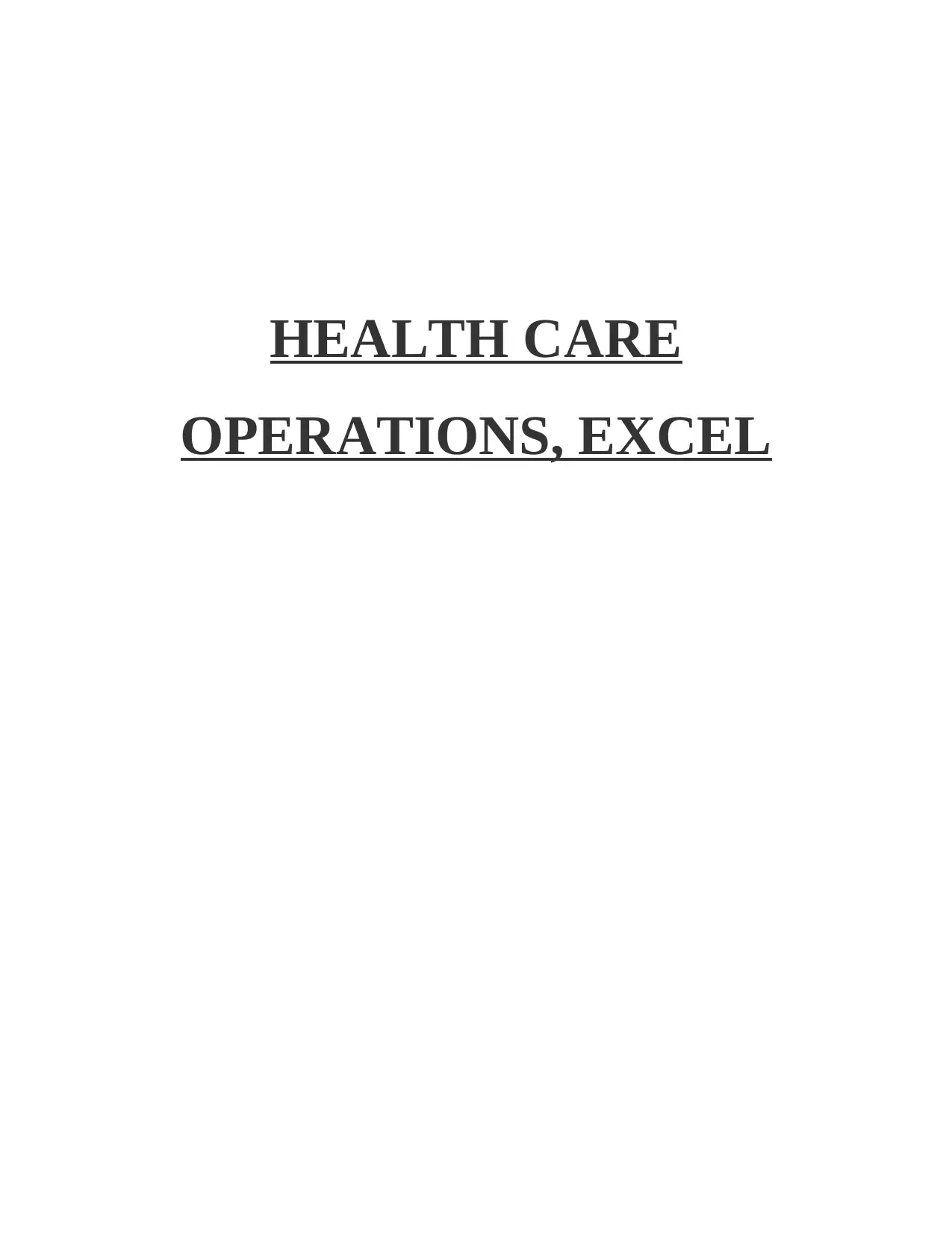
HEALTH CARE
OPERATIONS, EXCEL
OPERATIONS, EXCEL
Paraphrase This Document
Need a fresh take? Get an instant paraphrase of this document with our AI Paraphraser
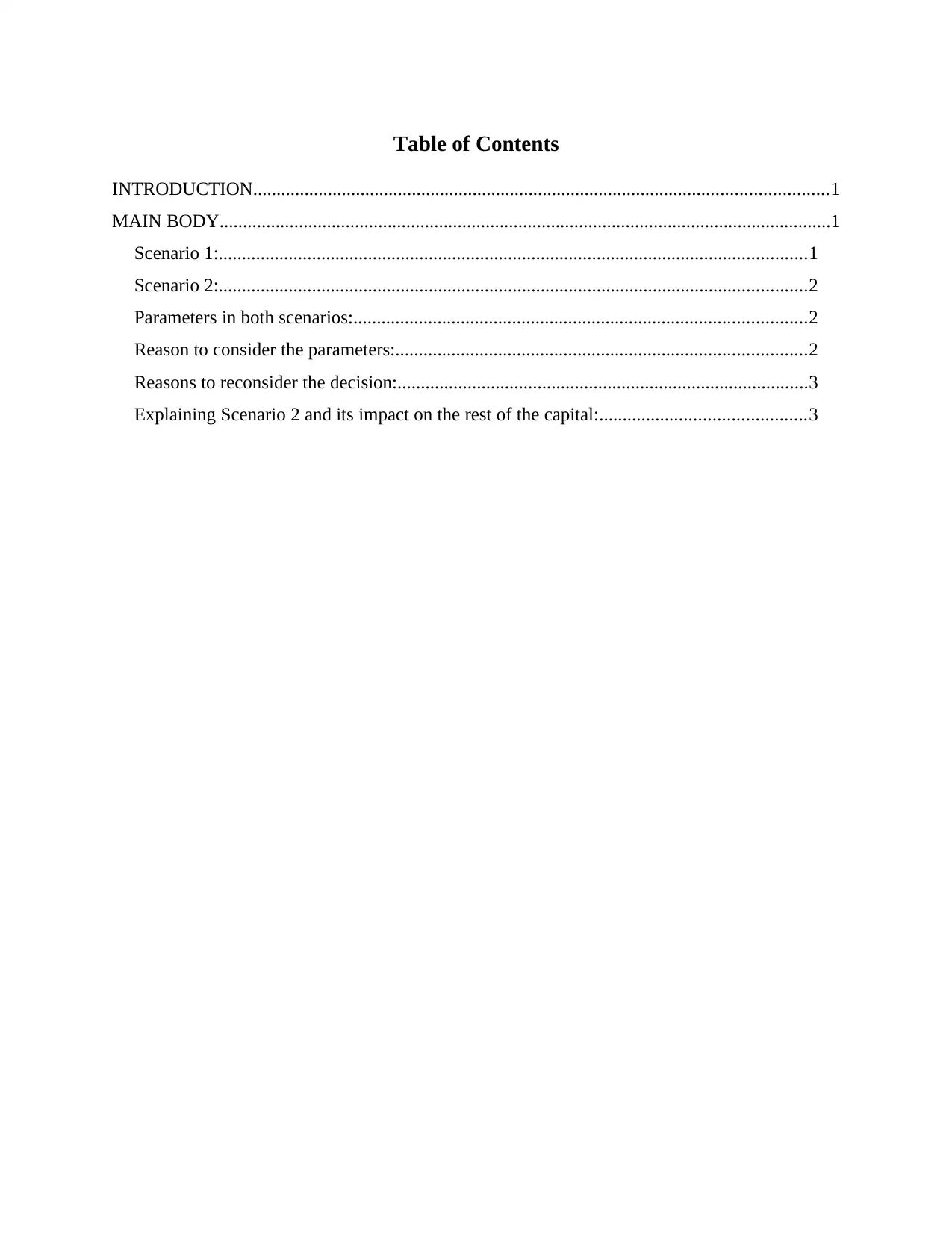
Table of Contents
INTRODUCTION...........................................................................................................................1
MAIN BODY...................................................................................................................................1
Scenario 1:..............................................................................................................................1
Scenario 2:..............................................................................................................................2
Parameters in both scenarios:.................................................................................................2
Reason to consider the parameters:........................................................................................2
Reasons to reconsider the decision:........................................................................................3
Explaining Scenario 2 and its impact on the rest of the capital:............................................3
INTRODUCTION...........................................................................................................................1
MAIN BODY...................................................................................................................................1
Scenario 1:..............................................................................................................................1
Scenario 2:..............................................................................................................................2
Parameters in both scenarios:.................................................................................................2
Reason to consider the parameters:........................................................................................2
Reasons to reconsider the decision:........................................................................................3
Explaining Scenario 2 and its impact on the rest of the capital:............................................3
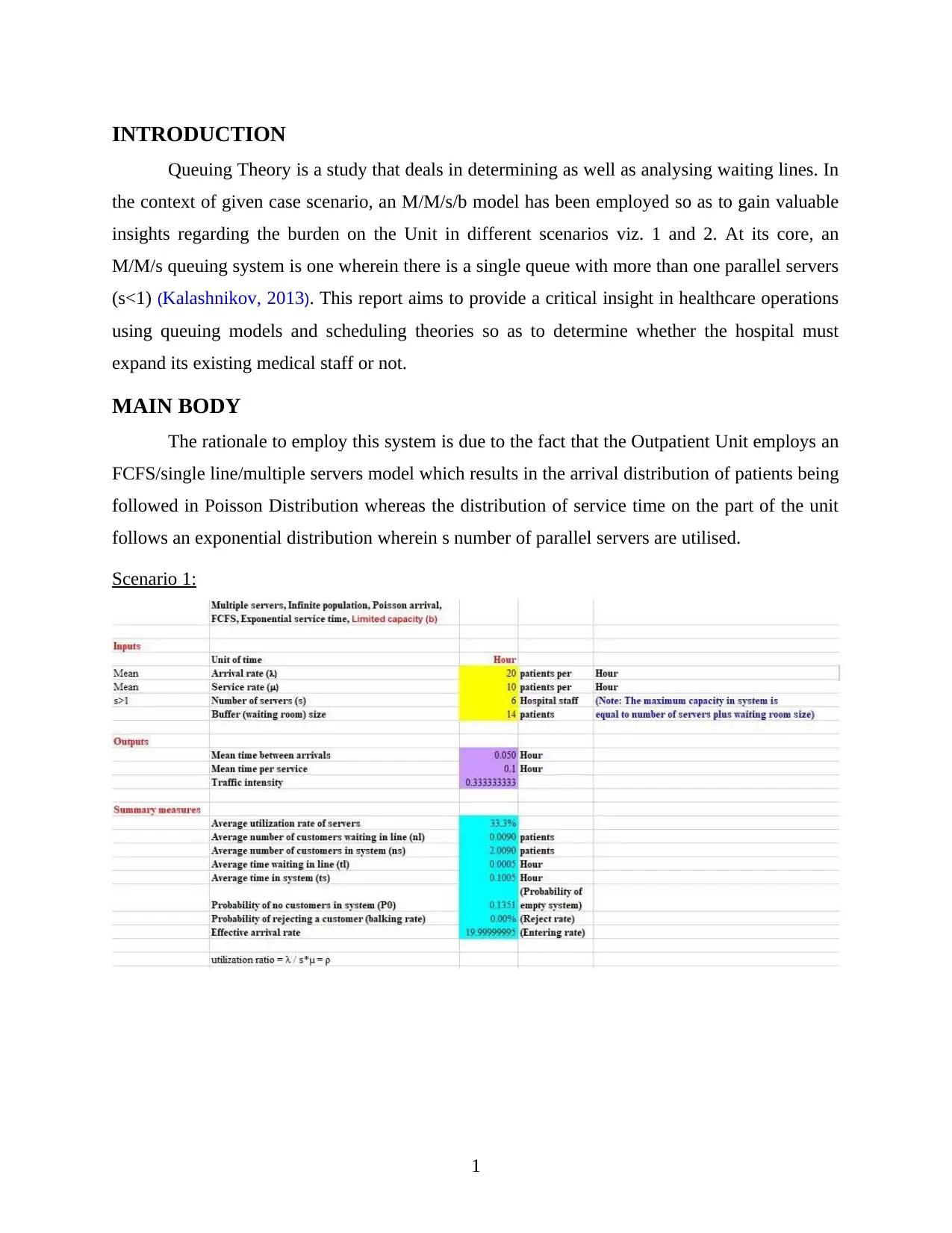
INTRODUCTION
Queuing Theory is a study that deals in determining as well as analysing waiting lines. In
the context of given case scenario, an M/M/s/b model has been employed so as to gain valuable
insights regarding the burden on the Unit in different scenarios viz. 1 and 2. At its core, an
M/M/s queuing system is one wherein there is a single queue with more than one parallel servers
(s<1) (Kalashnikov, 2013). This report aims to provide a critical insight in healthcare operations
using queuing models and scheduling theories so as to determine whether the hospital must
expand its existing medical staff or not.
MAIN BODY
The rationale to employ this system is due to the fact that the Outpatient Unit employs an
FCFS/single line/multiple servers model which results in the arrival distribution of patients being
followed in Poisson Distribution whereas the distribution of service time on the part of the unit
follows an exponential distribution wherein s number of parallel servers are utilised.
Scenario 1:
1
Queuing Theory is a study that deals in determining as well as analysing waiting lines. In
the context of given case scenario, an M/M/s/b model has been employed so as to gain valuable
insights regarding the burden on the Unit in different scenarios viz. 1 and 2. At its core, an
M/M/s queuing system is one wherein there is a single queue with more than one parallel servers
(s<1) (Kalashnikov, 2013). This report aims to provide a critical insight in healthcare operations
using queuing models and scheduling theories so as to determine whether the hospital must
expand its existing medical staff or not.
MAIN BODY
The rationale to employ this system is due to the fact that the Outpatient Unit employs an
FCFS/single line/multiple servers model which results in the arrival distribution of patients being
followed in Poisson Distribution whereas the distribution of service time on the part of the unit
follows an exponential distribution wherein s number of parallel servers are utilised.
Scenario 1:
1
⊘ This is a preview!⊘
Do you want full access?
Subscribe today to unlock all pages.

Trusted by 1+ million students worldwide
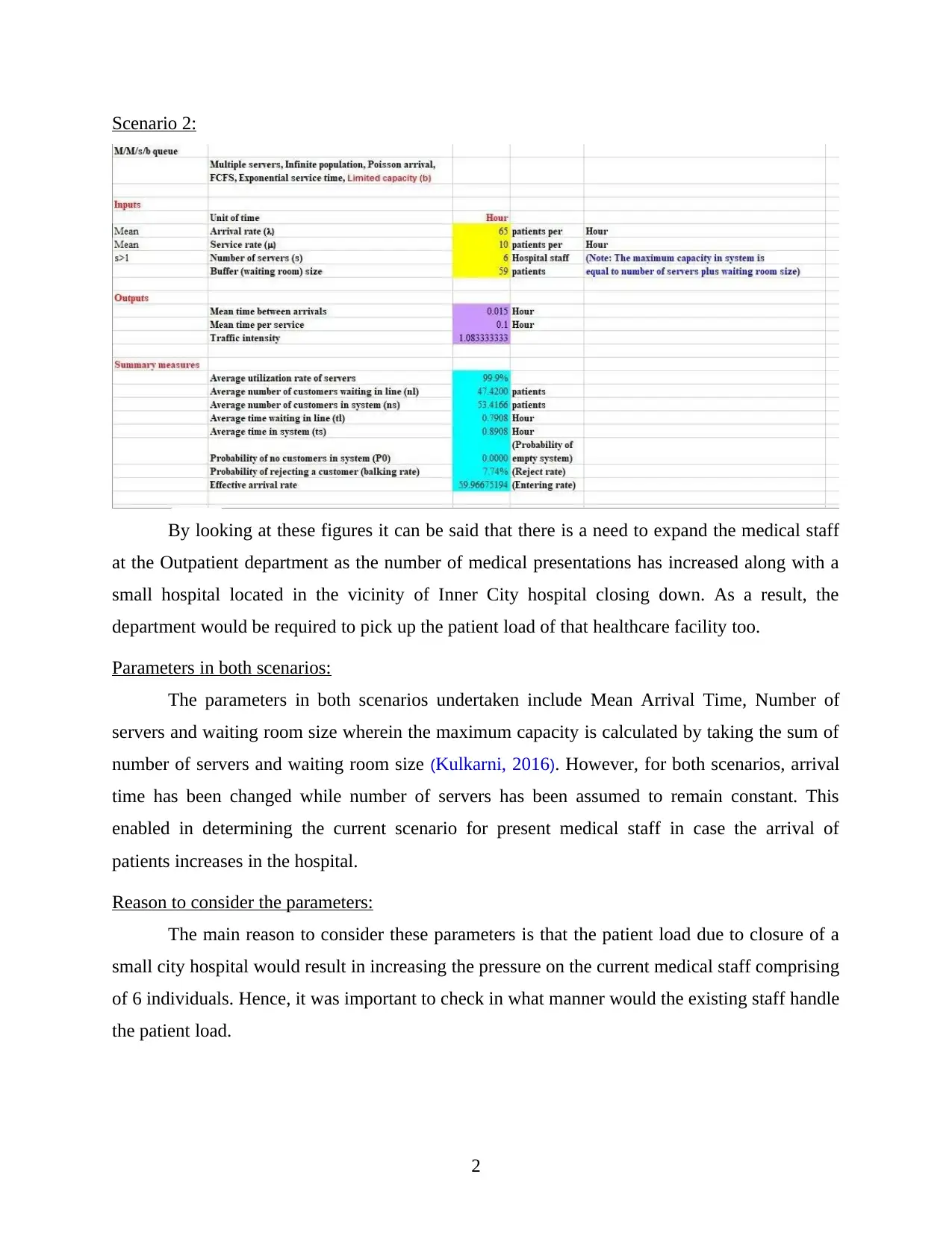
Scenario 2:
By looking at these figures it can be said that there is a need to expand the medical staff
at the Outpatient department as the number of medical presentations has increased along with a
small hospital located in the vicinity of Inner City hospital closing down. As a result, the
department would be required to pick up the patient load of that healthcare facility too.
Parameters in both scenarios:
The parameters in both scenarios undertaken include Mean Arrival Time, Number of
servers and waiting room size wherein the maximum capacity is calculated by taking the sum of
number of servers and waiting room size (Kulkarni, 2016). However, for both scenarios, arrival
time has been changed while number of servers has been assumed to remain constant. This
enabled in determining the current scenario for present medical staff in case the arrival of
patients increases in the hospital.
Reason to consider the parameters:
The main reason to consider these parameters is that the patient load due to closure of a
small city hospital would result in increasing the pressure on the current medical staff comprising
of 6 individuals. Hence, it was important to check in what manner would the existing staff handle
the patient load.
2
By looking at these figures it can be said that there is a need to expand the medical staff
at the Outpatient department as the number of medical presentations has increased along with a
small hospital located in the vicinity of Inner City hospital closing down. As a result, the
department would be required to pick up the patient load of that healthcare facility too.
Parameters in both scenarios:
The parameters in both scenarios undertaken include Mean Arrival Time, Number of
servers and waiting room size wherein the maximum capacity is calculated by taking the sum of
number of servers and waiting room size (Kulkarni, 2016). However, for both scenarios, arrival
time has been changed while number of servers has been assumed to remain constant. This
enabled in determining the current scenario for present medical staff in case the arrival of
patients increases in the hospital.
Reason to consider the parameters:
The main reason to consider these parameters is that the patient load due to closure of a
small city hospital would result in increasing the pressure on the current medical staff comprising
of 6 individuals. Hence, it was important to check in what manner would the existing staff handle
the patient load.
2
Paraphrase This Document
Need a fresh take? Get an instant paraphrase of this document with our AI Paraphraser
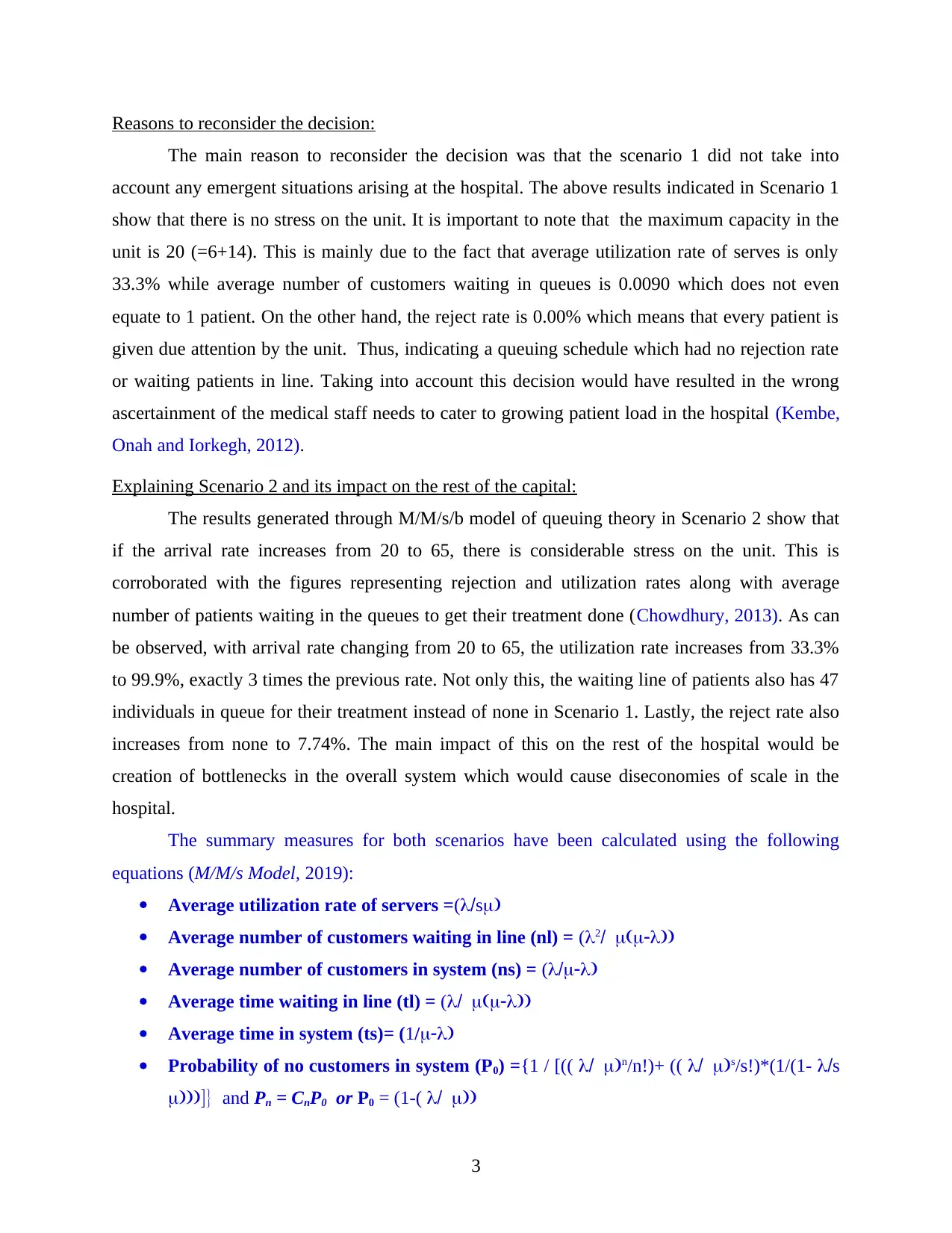
Reasons to reconsider the decision:
The main reason to reconsider the decision was that the scenario 1 did not take into
account any emergent situations arising at the hospital. The above results indicated in Scenario 1
show that there is no stress on the unit. It is important to note that the maximum capacity in the
unit is 20 (=6+14). This is mainly due to the fact that average utilization rate of serves is only
33.3% while average number of customers waiting in queues is 0.0090 which does not even
equate to 1 patient. On the other hand, the reject rate is 0.00% which means that every patient is
given due attention by the unit. Thus, indicating a queuing schedule which had no rejection rate
or waiting patients in line. Taking into account this decision would have resulted in the wrong
ascertainment of the medical staff needs to cater to growing patient load in the hospital (Kembe,
Onah and Iorkegh, 2012).
Explaining Scenario 2 and its impact on the rest of the capital:
The results generated through M/M/s/b model of queuing theory in Scenario 2 show that
if the arrival rate increases from 20 to 65, there is considerable stress on the unit. This is
corroborated with the figures representing rejection and utilization rates along with average
number of patients waiting in the queues to get their treatment done (Chowdhury, 2013). As can
be observed, with arrival rate changing from 20 to 65, the utilization rate increases from 33.3%
to 99.9%, exactly 3 times the previous rate. Not only this, the waiting line of patients also has 47
individuals in queue for their treatment instead of none in Scenario 1. Lastly, the reject rate also
increases from none to 7.74%. The main impact of this on the rest of the hospital would be
creation of bottlenecks in the overall system which would cause diseconomies of scale in the
hospital.
The summary measures for both scenarios have been calculated using the following
equations (M/M/s Model, 2019):
Average utilization rate of servers =(l/sm)
Average number of customers waiting in line (nl) = (l2/ m(m-l))
Average number of customers in system (ns) = (l/m-l)
Average time waiting in line (tl) = (l/ m(m-l))
Average time in system (ts)= (1/m-l)
Probability of no customers in system (P0) ={1 / [(( l/ m)n/n!)+ (( l/ m)s/s!)*(1/(1- l/s
m)))]} and Pn = CnP0 or P0 = (1-( l/ m))
3
The main reason to reconsider the decision was that the scenario 1 did not take into
account any emergent situations arising at the hospital. The above results indicated in Scenario 1
show that there is no stress on the unit. It is important to note that the maximum capacity in the
unit is 20 (=6+14). This is mainly due to the fact that average utilization rate of serves is only
33.3% while average number of customers waiting in queues is 0.0090 which does not even
equate to 1 patient. On the other hand, the reject rate is 0.00% which means that every patient is
given due attention by the unit. Thus, indicating a queuing schedule which had no rejection rate
or waiting patients in line. Taking into account this decision would have resulted in the wrong
ascertainment of the medical staff needs to cater to growing patient load in the hospital (Kembe,
Onah and Iorkegh, 2012).
Explaining Scenario 2 and its impact on the rest of the capital:
The results generated through M/M/s/b model of queuing theory in Scenario 2 show that
if the arrival rate increases from 20 to 65, there is considerable stress on the unit. This is
corroborated with the figures representing rejection and utilization rates along with average
number of patients waiting in the queues to get their treatment done (Chowdhury, 2013). As can
be observed, with arrival rate changing from 20 to 65, the utilization rate increases from 33.3%
to 99.9%, exactly 3 times the previous rate. Not only this, the waiting line of patients also has 47
individuals in queue for their treatment instead of none in Scenario 1. Lastly, the reject rate also
increases from none to 7.74%. The main impact of this on the rest of the hospital would be
creation of bottlenecks in the overall system which would cause diseconomies of scale in the
hospital.
The summary measures for both scenarios have been calculated using the following
equations (M/M/s Model, 2019):
Average utilization rate of servers =(l/sm)
Average number of customers waiting in line (nl) = (l2/ m(m-l))
Average number of customers in system (ns) = (l/m-l)
Average time waiting in line (tl) = (l/ m(m-l))
Average time in system (ts)= (1/m-l)
Probability of no customers in system (P0) ={1 / [(( l/ m)n/n!)+ (( l/ m)s/s!)*(1/(1- l/s
m)))]} and Pn = CnP0 or P0 = (1-( l/ m))
3
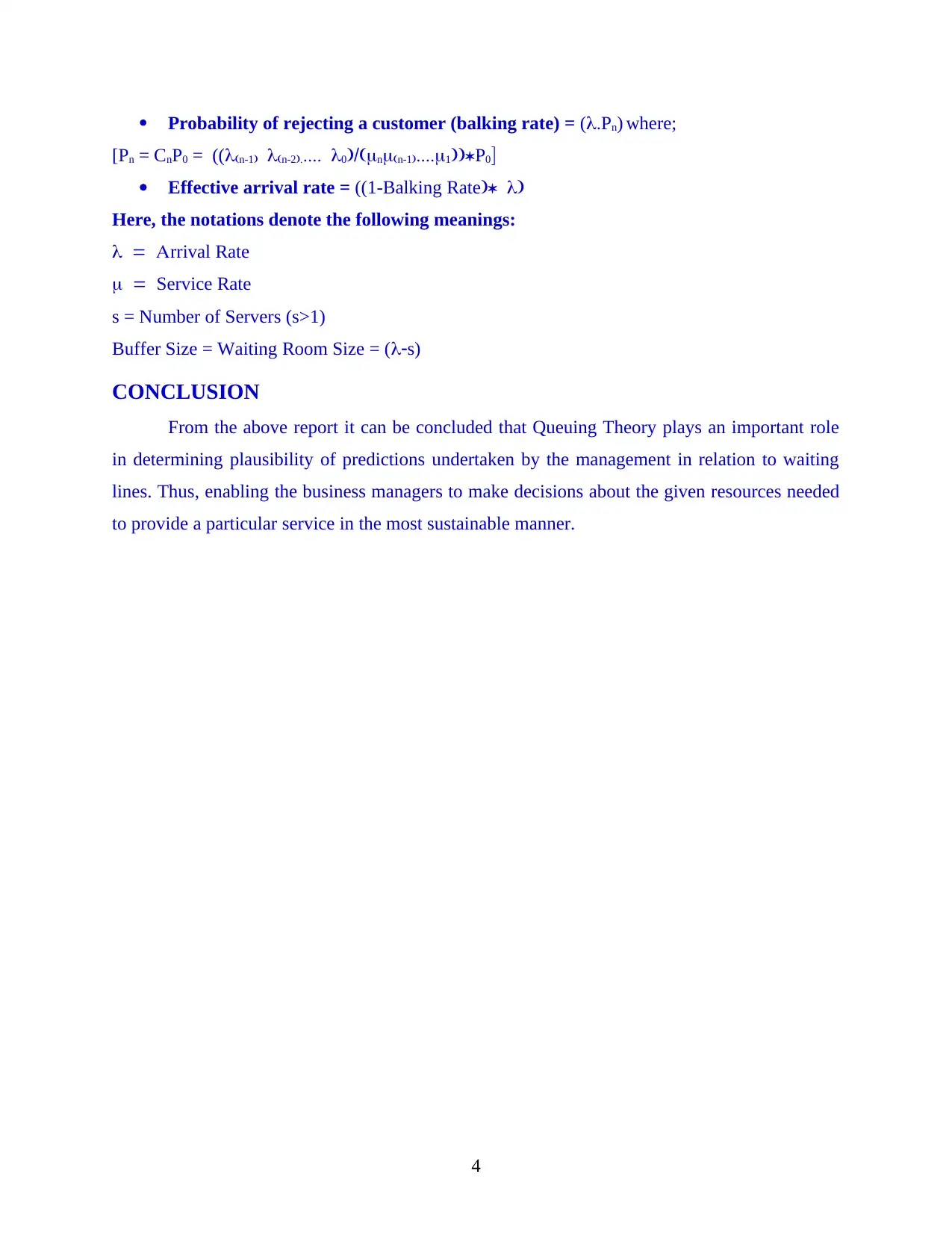
Probability of rejecting a customer (balking rate) = (l.Pn) where;
[Pn = CnP0 = ((l(n-1) l(n-2)..... l0)/(mnm(n-1)....m1))*P0]
Effective arrival rate = ((1-Balking Rate)* l)
Here, the notations denote the following meanings:
l = Arrival Rate
m = Service Rate
s = Number of Servers (s>1)
Buffer Size = Waiting Room Size = (l-s)
CONCLUSION
From the above report it can be concluded that Queuing Theory plays an important role
in determining plausibility of predictions undertaken by the management in relation to waiting
lines. Thus, enabling the business managers to make decisions about the given resources needed
to provide a particular service in the most sustainable manner.
4
[Pn = CnP0 = ((l(n-1) l(n-2)..... l0)/(mnm(n-1)....m1))*P0]
Effective arrival rate = ((1-Balking Rate)* l)
Here, the notations denote the following meanings:
l = Arrival Rate
m = Service Rate
s = Number of Servers (s>1)
Buffer Size = Waiting Room Size = (l-s)
CONCLUSION
From the above report it can be concluded that Queuing Theory plays an important role
in determining plausibility of predictions undertaken by the management in relation to waiting
lines. Thus, enabling the business managers to make decisions about the given resources needed
to provide a particular service in the most sustainable manner.
4
⊘ This is a preview!⊘
Do you want full access?
Subscribe today to unlock all pages.

Trusted by 1+ million students worldwide
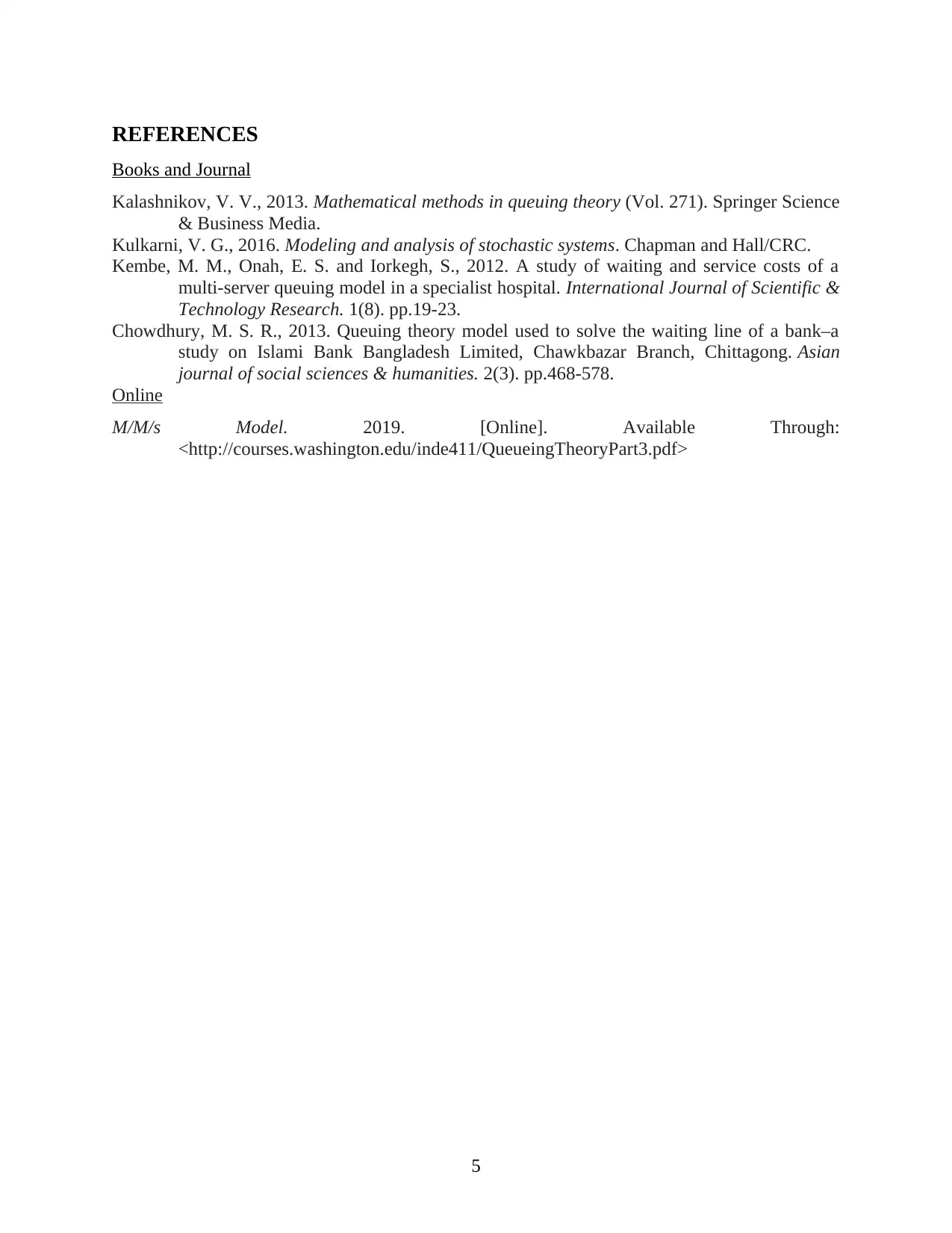
REFERENCES
Books and Journal
Kalashnikov, V. V., 2013. Mathematical methods in queuing theory (Vol. 271). Springer Science
& Business Media.
Kulkarni, V. G., 2016. Modeling and analysis of stochastic systems. Chapman and Hall/CRC.
Kembe, M. M., Onah, E. S. and Iorkegh, S., 2012. A study of waiting and service costs of a
multi-server queuing model in a specialist hospital. International Journal of Scientific &
Technology Research. 1(8). pp.19-23.
Chowdhury, M. S. R., 2013. Queuing theory model used to solve the waiting line of a bank–a
study on Islami Bank Bangladesh Limited, Chawkbazar Branch, Chittagong. Asian
journal of social sciences & humanities. 2(3). pp.468-578.
Online
M/M/s Model. 2019. [Online]. Available Through:
<http://courses.washington.edu/inde411/QueueingTheoryPart3.pdf>
5
Books and Journal
Kalashnikov, V. V., 2013. Mathematical methods in queuing theory (Vol. 271). Springer Science
& Business Media.
Kulkarni, V. G., 2016. Modeling and analysis of stochastic systems. Chapman and Hall/CRC.
Kembe, M. M., Onah, E. S. and Iorkegh, S., 2012. A study of waiting and service costs of a
multi-server queuing model in a specialist hospital. International Journal of Scientific &
Technology Research. 1(8). pp.19-23.
Chowdhury, M. S. R., 2013. Queuing theory model used to solve the waiting line of a bank–a
study on Islami Bank Bangladesh Limited, Chawkbazar Branch, Chittagong. Asian
journal of social sciences & humanities. 2(3). pp.468-578.
Online
M/M/s Model. 2019. [Online]. Available Through:
<http://courses.washington.edu/inde411/QueueingTheoryPart3.pdf>
5
1 out of 7
Your All-in-One AI-Powered Toolkit for Academic Success.
+13062052269
info@desklib.com
Available 24*7 on WhatsApp / Email
![[object Object]](/_next/static/media/star-bottom.7253800d.svg)
Unlock your academic potential
Copyright © 2020–2025 A2Z Services. All Rights Reserved. Developed and managed by ZUCOL.
